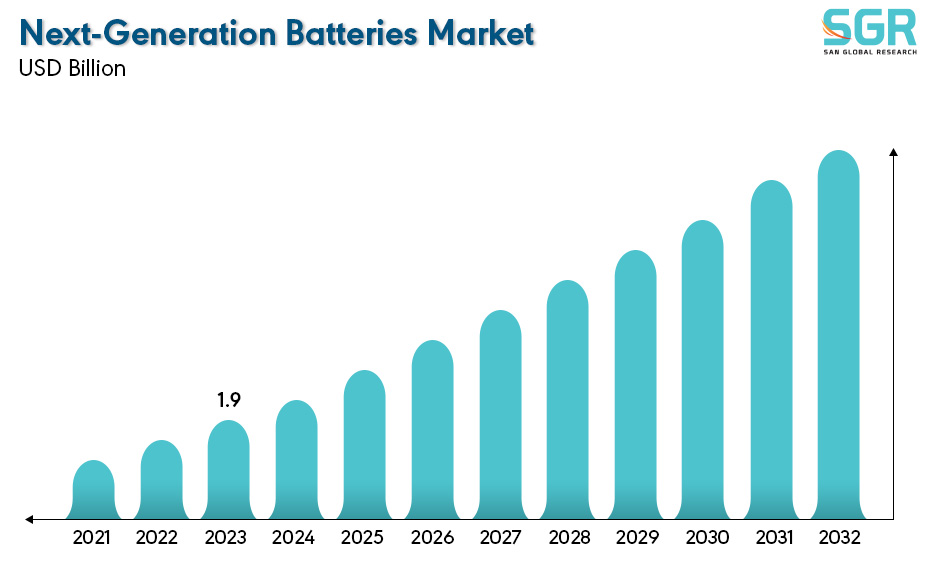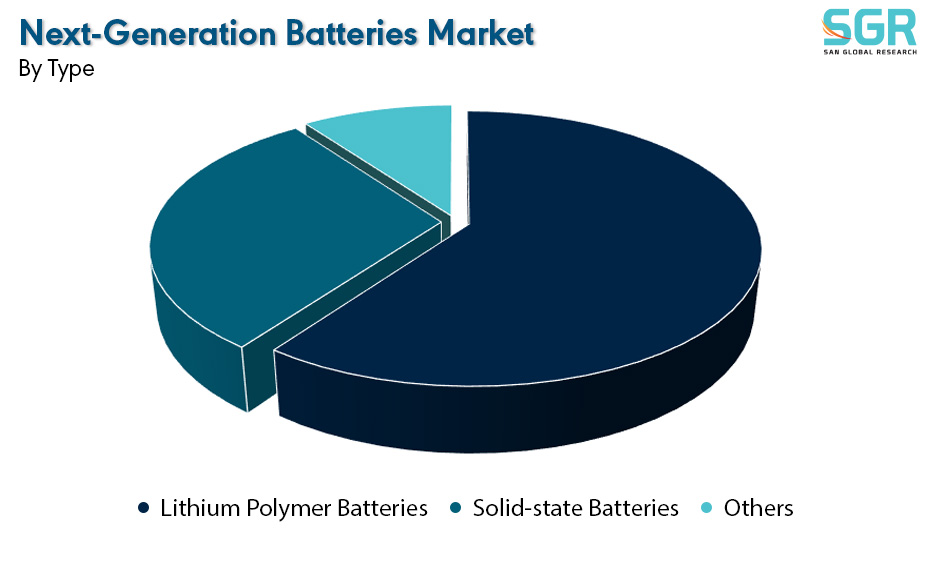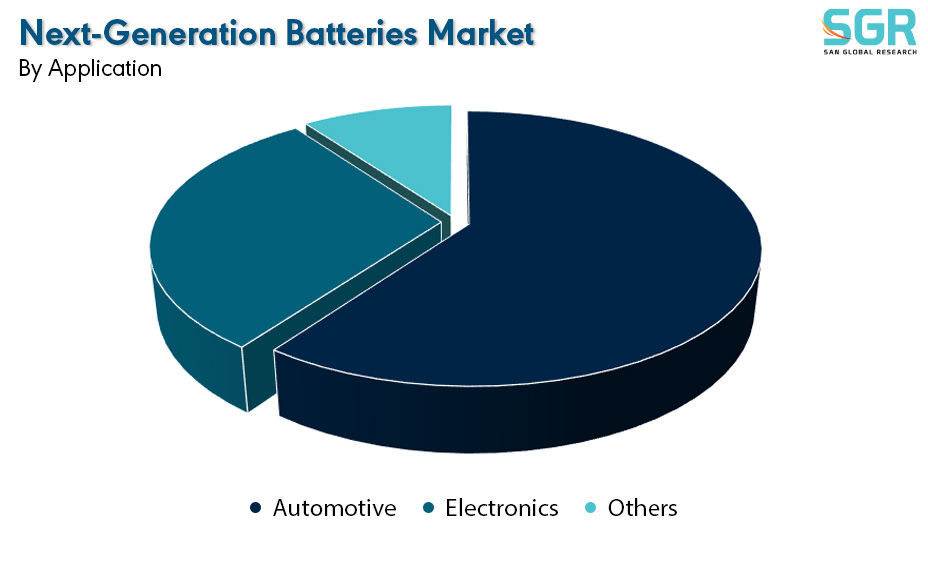Next-Generation Batteries Market is estimated to be worth USD 1.9 Billion in 2023 and is projected to grow at a CAGR of 7.6% between 2023 to 2032. The study has considered the base year as 2022, which estimates the market size of market and the forecast period is 2023 to 2032. The report analyzes and forecasts the market size, in terms of value (USD Billion), for the market. The report segments the market and forecasts it by Type, by Application and by region/country.

Next-Generation Batteries Market refers to the market segment that involves the development, production, and commercialization of advanced and innovative battery technologies. These batteries are considered to be the next generation beyond traditional lithium-ion batteries, which have been widely used in various electronic devices and electric vehicles.
Next-generation batteries aim to address some of the limitations of current battery technologies, such as energy density, charging speed, cost, and environmental impact. The market includes a variety of emerging battery technologies, such as Solid-State Batteries, Lithium-Sulfur Batteries, Flow Batteries, Graphene-Based Batteries etc. The Next-Generation Batteries Market is driven by the increasing demand for energy storage solutions, especially in renewable energy systems, electric vehicles, and portable electronics. Researchers and companies are continuously working on improving the efficiency, safety, and environmental sustainability of batteries to meet the growing needs of various industries.
.jpg)
Region wise Comparison:
The demand for Next-Generation Batteries in North America was growing steadily. The push towards cleaner and more sustainable energy solutions, coupled with the increasing adoption of electric vehicles (EVs) and renewable energy sources, has driven the demand for advanced battery technologies in the region. The automotive industry is a significant driver of the demand for advanced batteries. As the interest in electric vehicles continues to rise, there is a growing need for batteries that offer higher energy density, faster charging times, and longer life cycles. Next-generation batteries, such as solid-state batteries and lithium-sulfur batteries, are being explored to meet these requirements.
Europe has been actively pursuing sustainable and low-carbon energy solutions, and the automotive industry, in particular, has seen significant advancements in electric mobility. Europe has been a leader in the adoption of renewable energy sources. As the share of solar and wind power in the energy mix increases, there is a growing need for efficient energy storage solutions. Next-generation batteries play a crucial role in storing renewable energy for times of high demand or when renewable sources are not generating power.
.jpg)
The APAC region is a key player in the global market for advanced battery technologies, driven by factors such as rapid industrialization, urbanization, government initiatives, and a growing awareness of the need for cleaner and more sustainable energy solutions. The Asia-Pacific region is a major hub for the production and consumption of consumer electronics. Next-generation batteries with improved energy density, safety features, and longer lifespan are sought after for use in smartphones, laptops, wearables, and other portable devices.
The demand for Next-Generation Batteries in the Middle East and Africa (MEA) region was emerging, but the extent of demand was not as pronounced as in some other regions. In certain areas of the MEA region, where access to centralized power grids is limited, off-grid and remote applications may drive the demand for energy storage solutions. Advanced batteries could be essential for providing reliable power in such scenarios.
.jpg)
Segmentation:
The Next-Generation Batteries Market is segmented by type, by application and by region/country.
By Type:

Based on the type, the Next-Generation Batteries Market is bifurcated into Lithium Polymer Batteries, Solid-state Batteries and others – where Lithium Polymer Batteries is dominating and ahead in terms of share.
Lithium Polymer (Li-Po) batteries are a type of rechargeable battery that falls under the broader category of lithium-ion batteries. While lithium-ion batteries, in general, have been widely used in various applications, including consumer electronics and electric vehicles, Li-Po batteries offer some specific advantages and characteristics. Some key features of Li-Po batteries are they are Thin and Flexible Form Factor, Lightweight, Higher Energy Density, Customizable Shapes etc. Li-Po batteries often offer higher energy density compared to traditional lithium-ion batteries. This means they can store more energy in a given volume or weight, making them attractive for applications where maximizing energy storage in a limited space is crucial. While Li-Po batteries are an important and widely used technology, it's essential to note that other emerging battery technologies, such as solid-state batteries and lithium-sulfur batteries, are also considered part of the Next-Generation Batteries landscape, each with its own set of advantages and applications.
By Application:

Based on the application, the Next-Generation Batteries Market is bifurcated into Automotive, Electronics and Others – where Automotive is dominating and ahead in terms of share.
On the basis of region
• North America
• Europe
• Asia Pacific
• South America and
• Middle East and Africa
In 2022, North America is anticipated to dominate the Next-Generation Batteries Market with market revenue of XX USD Million with a registered CAGR of XX%.
Key Players:
The key market players operating in the Next-Generation Batteries Market include
• Blue Solutions
• Routejade
• Renata SA
• BrightVolt
• ProLogium Technology
• Cymbet
• Enfucell
• Zinergy UK
• ZEUS Battery Products
• Jenax Inc.
• Molex
• WeLion New Energy
• QingTao KunShan Energy Development
• Ilika
Drivers:
Higher Demand for Energy Density
Next-Generation Batteries, encompassing various emerging technologies beyond traditional lithium-ion batteries, possess several strengths that make them promising for a wide range of applications. Many Next-Generation Batteries aim to achieve higher energy density, meaning they can store more energy per unit weight or volume. This is crucial for applications such as electric vehicles, where maximizing the driving range is a significant factor. Higher energy density in the context of Next-Generation Batteries refers to the ability of a battery to store more energy per unit of volume or weight. It is a crucial parameter that directly impacts the performance and efficiency of a battery, especially in applications where maximizing energy storage capacity is essential.
Opportunity:
Adoption of Electric Vehicles (EVs)
The transition to electric mobility represents a significant opportunity for Next-Generation Batteries. Improved energy density, faster charging, and longer cycle life can enhance the performance and attractiveness of electric vehicles, contributing to the growth of the EV market. Next-Generation Batteries aim to achieve higher energy density, meaning they can store more energy in a given volume or weight. This is particularly important for electric vehicles, as higher energy density allows for longer driving ranges on a single charge. EVs equipped with batteries offering improved energy density can potentially compete more effectively with traditional internal combustion engine vehicles.
| Report Attribute | Details |
| Market Value in 2022 | 1.7 Billion |
| Forecast in 2032 | 7.3 Billion |
| CAGR | CAGR of 15.70% from 2024 to 2032 |
| Base Year of forecast | 2023 |
| Historical | 2019-2022 |
| Units | Revenue in USD Billion and CAGR from 2023 to 2032 |
| Report Coverage | Revenue forecast, Industry outlook, competitive landscape, growth factors, and trends |
| Segments Scope | By Type, By Application |
| Regions Covered | North America, Europe, Asia Pacific, SA and MEA |
| Key Companies profiled | • Blue Solutions, • Routejade, • Renata SA, • BrightVolt, • ProLogium Technology, • Cymbet, • Enfucell, • Zinergy UK, • ZEUS Battery Products Jenax Inc., • Molex, • WeLion New Energy, • QingTao KunShan Energy Development, • Ilika |

 Description
Description
 Table of Content
Table of Content
 Gera Imperium Rise,
Gera Imperium Rise,  +91 9209275355
+91 9209275355


